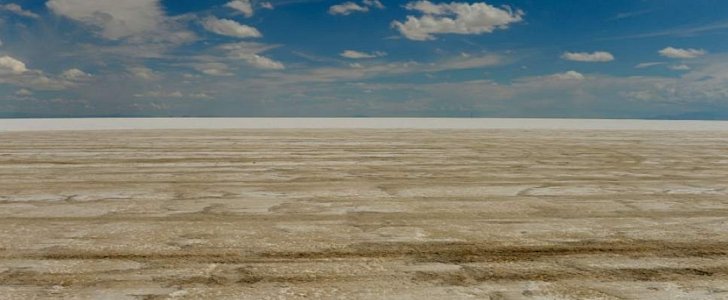The future doesn't look too bright at all for the Bonneville Salt Flats as the salt surface that made possible so many land speed records is deteriorating fast. The Salt Flats have started to be affected by problems more and more often, with the quality of the salt surface becoming an issue that might lead to canceling the races.
About one year ago, we told you that the Bonneville Salt Flats received 2,000 tons of dry salt, as part of a larger project coordinated by the Save the Salt Coalition and involving SEMA (Specialty Equipment Market Association), the Southern California Timing Association (SCTA) and the US Bureau of Land Management (BLM).
Southern California Timing Association's Russ Eyers has traveled to the Salt Flats to inspect the condition of the salt surface and his findings are worrying to say the least. "I was actually out there for the past three or four days. I was doing the surveying and grading, trying to find a place to hold a meet, and we just didn't get there," he adds.
The Speed Week should start on August 8th, but Eyers is not exactly sure that the condition of the salt surface will permit. The area covered by salt is getting smaller each year, and the thickness of the salt layer has decreased significantly. The salt used to be two to three feet (66-100cm) thick back in the '40s and '50s and gradually decreased.
Unfortunately, unless a dramatic change is made in what's going on at the Bonneville Salt Flats, the good old days of speed racing and an entire land speed piece of heritage are going to be lost forever as the flats will disappear.
Mining destroys the Salt Flats
Still, things are far from being alright, despite such efforts. According to the Salt Lake Tribune, the local mining industry has removed excessive amounts of salt for the area, accelerating the decay of this National Monument. Even more, rains last year and this spring caused mud to flow into the salt flats area, damaging the surface that was used as raceways.Southern California Timing Association's Russ Eyers has traveled to the Salt Flats to inspect the condition of the salt surface and his findings are worrying to say the least. "I was actually out there for the past three or four days. I was doing the surveying and grading, trying to find a place to hold a meet, and we just didn't get there," he adds.
The Speed Week should start on August 8th, but Eyers is not exactly sure that the condition of the salt surface will permit. The area covered by salt is getting smaller each year, and the thickness of the salt layer has decreased significantly. The salt used to be two to three feet (66-100cm) thick back in the '40s and '50s and gradually decreased.
Land speed racing could easily become a thing of the past as the Flats will disappear
The dangerously-thin salt layer reveals unstable dirt below it, and such surfaces are in no way fit for racing and land speed records attempts. With few weeks remaining until the Speed Week should kick off, the only hope for Salt Flats racing this year lies in finding an area where the salt layer is still strong enough to support the speed demons. That is, a place that's still not affected to an acceptable degree... because it looks like no square inch in the valley was left untouched by the abusive behavior.Unfortunately, unless a dramatic change is made in what's going on at the Bonneville Salt Flats, the good old days of speed racing and an entire land speed piece of heritage are going to be lost forever as the flats will disappear.










